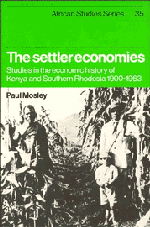Book contents
- Frontmatter
- Contents
- List of maps
- List of tables
- List of figures
- Preface
- A note on currency
- Abbreviations
- Kenya and Southern Rhodesia: principal place names
- 1 Introduction
- 2 The political constraints on economic behaviour
- 3 African agricultural development
- 4 The labour market
- 5 European agriculture
- 6 Secondary industry
- 7 Conclusions
- Notes
- Bibliography
- Index
3 - African agricultural development
Published online by Cambridge University Press: 04 August 2010
- Frontmatter
- Contents
- List of maps
- List of tables
- List of figures
- Preface
- A note on currency
- Abbreviations
- Kenya and Southern Rhodesia: principal place names
- 1 Introduction
- 2 The political constraints on economic behaviour
- 3 African agricultural development
- 4 The labour market
- 5 European agriculture
- 6 Secondary industry
- 7 Conclusions
- Notes
- Bibliography
- Index
Summary
Chairman What resources have the Natives today from which you could find funds to promote their interests?
Chief Native Commissioner The biggest source today, I think, is cattle. And the price of maize today is higher than it has been for some considerable time. They are fortunate in having surplus crops for sale.
Chairman What other sources of wealth have the natives?
Chief Native Commissioner Labour.
NAR: ZBJ 1/1/1, Evidence to the Native Production and Trade Commission, 1944, p. 7.INTRODUCTION: A THEORETICAL PERSPECTIVE
Background
The purpose of this chapter is to examine the extent and causes of development in African agriculture in the settler economies, in the light of the policy-induced constraints discussed in the last chapter.
We begin by setting out, in Table 3.1, some aggregative data on developments in the African agricultural economy. These cover the only variables of which we have estimates running right through the colonial period: namely in Southern Rhodesia, total production of grains (maize, millets, wheat, groundnuts, rice), in Kenya, agricultural exports of African origin, and in both countries, the African cattle herd. They are not of a reliability which enables firm inferences to be made from them. However, it can be said that they offer no support to the more extravagant allegations of continuous agricultural decline made by commentators of the ‘underdevelopment’ school: for example, Arrighi's reference to a ‘progressive decline’ in the overall productivity of the African peasantry, Good's suggestion that ‘a disintegration of the peasantries … occurred in all the [settler] states of Africa with varying time-span and intensity’; and, most forthright of all, Palmer's statement that by the end of the 1930s ‘the agricultural economy of the Shona and the Ndebele, like that of the Kikuyu and most South African peoples, had been destroyed’.
- Type
- Chapter
- Information
- The Settler EconomiesStudies in the Economic History of Kenya and Southern Rhodesia 1900–1963, pp. 71 - 113Publisher: Cambridge University PressPrint publication year: 1983

